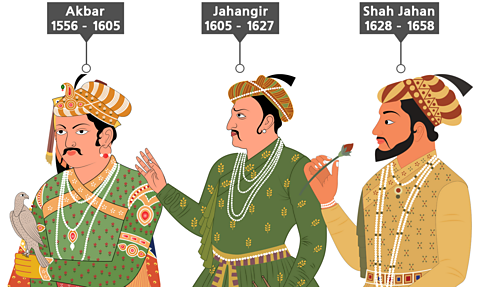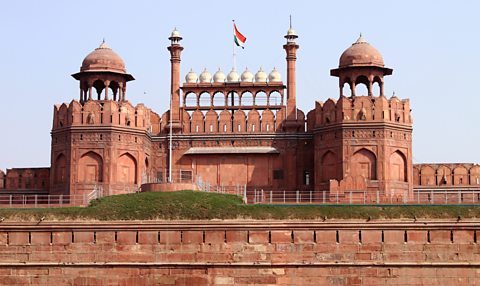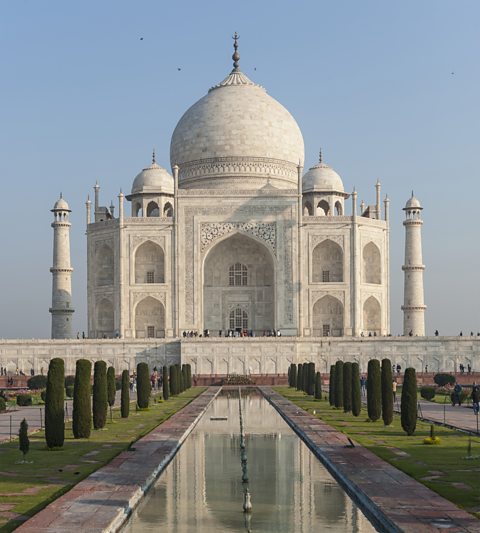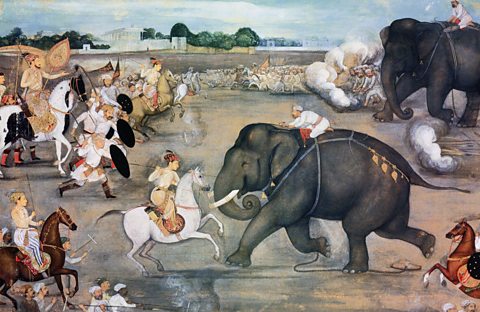Key points
- Aurangzeb is remembered as the last great Mughal emperor, ruling Mughal India for nearly 50 years. Aurangzeb’s complicated and contradictory character has meant that his legacy is still debated today.
- Some historians argue that Aurangzeb was a brutal and merciless ruler to anyone who posed a threat to his empire.
- Some historians argue that he was a pious ruler who sought to ensure justice and protect Mughal culture and values at all costs.
- Other historians suggest that he was both brutal and piousDeeply religious and living in a way that shows this belief..
- We have to look all areas of his rule to truly understand Aurangzeb and his legacy.
- Aurangzeb can be compared to previous Mughal emperors including Shah Jahan who is known for ordering the construction of the Taj Mahal complex.
Mughal emperors Akbar, Jahangir and Shah Jahan

Who was Emperor Akbar?
Emperor Akbar, known as Akbar the Great, ruled Mughal India from 1556 to 1605. He was known for his religious tolerance and interest in other cultures. When he died in 1605, he had expanded the Mughal Empire to cover much of modern day India.
Who was Emperor Jahangir and what happened to him?
The next emperor was the son of Akbar, Jahangir. He was the ruler of the Mughal Empire from 1605 until 1627. He added little new territory and shortly after becoming emperor he came to struggle with drug and alcohol addictions. However, his wife, Nur Jahan, would rule as co-sovereign as Jahangir’s addictions left him unable to rule. This was unheard of in the Mughal Empire and reveals the impressive achievement and ability of Nur Jahan. Under the guidance of Nur Jahan, the Mughal Empire experienced a time of peace and prosperity.
When Jahangir died in 1627, a power struggle broke out among his sons. Shah Jahan, the third son of Jahangir, defeated his younger brother, Shahryar Mirza, in battle. He went on to execute his other brother, who had tried to claim the throne, before crowning himself emperor at the fort in Agra and would rule the Mughal Empire until 1657.
Shah Jahan's rule
Shah Jahan was a strong and wise ruler, he paid his advisors and generals lots of money to make sure they stayed loyal. This meant he had lots of support when he went to war to expand the Mughal Empire in the north and the south.
Shah Jahan spent huge amounts of money on buildings including the Red Fort and the Taj Mahal. He ordered many mosques, forts, hospitals, markets and schools to be built – some of which still exist today.

Who built the Taj Mahal?

Over 20,000 people were involved in its design and construction. The labourers and tradespeople who worked on the Taj Mahal came from the Mugal Empire and also from Central Asia and Iran.
Mughal Emperor Shah Jahan ordered the Taj Mahal to be constructed in memory of his beloved wife, Mumtaz Mahal, after she died in 1631.

Who was Aurangzeb?
Aurangzeb's early life
Aurangzeb was born in 1618, the third son of Shah Jahan and Mumtaz Mahal. Growing up a Mughal prince, he was highly educated but was also skilled in horse riding and the art of leading an army.
At only 16 years old he was sent to fight wars for his father against the Uzbeks and Persians. He was then sent to rule in Gujarat, Multan and Deccan – the last of which he renamed after himself. From his time as a prince, he proved that he was a strong ruler of the local provinces and a strong military leader.

Aurangzeb becomes emperor

In 1657 Shah Jahan fell ill and his three sons immediately prepared for war. In the Mughal Empire all sons were believed to have equal right to the throne, so each son quickly prepared to prove themselves as the greatest Mughal ruler.
Aurangzeb won the battle against his brothers. He ordered his oldest brother, who had spent years plotting to sabotage him, to be beheaded and imprisoned his father. Shah Jahan would live out his final years imprisoned by his son, with his daughter to care for him until he died in 1666. With the battle won, his brother executed, and his father imprisoned – Aurangzeb declared himself Emperor of Mughal India in 1658.

Emperor Aurangzeb, the pious

From the beginning of his rule, it was clear that Aurangzeb would be a far more strict ruler than the emperors before him. He was more piousDeeply religious and living in a way that shows this belief. than his father, grandfather, and great grandfather. He committed to avoiding alcohol and the drug opium – which had ruined the rule of previous emperors as their addictions made them unable to rule. He also memorised the entire Qur’an after becoming emperor.
He spent his time focusing on upholding justice and maintaining Mughal traditions. Unlike Shah Jahan, he did not spend lots of money on lots of grand buildings but instead spent money on building libraries and preserving Mughal laws. He summoned his court daily to discuss legal cases across his empire and ensure justice was being carried out.
Aurangzeb did spend money on one extravagant building, the world’s largest mosque at the time – the Badashi Mosque in Lahore. As Aurangzeb was building this mosque, he also put restrictions on the Hindu celebration of Diwali and announced that newly built Hindu temples would be destroyed. Some historians suggest that this was in response to a Hindu rebellion. However, even though this this order was never carried out, Aurangzeb’s commitment to Islamic law continued to cause tension between Muslims and Hindus in Mughal India.


Was Aurangzeb the first Mughal emperor to introduce more Islamic laws in the Mughal Empire?
No, the introduction of Islamic laws began under his father – Shah Jahan.
Emperor Aurangzeb, the tyrant

Although Aurangzeb was committed to justice and was a very pious man, he was also committed to expanding the empire and using as much force as he felt necessary to deal with any threats to his empire. As a result of his use of violence and force, many have called Aurangzeb a tyrantA cruel and oppressive ruler who is acts outside of the law and constitution and has unlimited power. since he was willing to go against his own beliefs to deal with rebellious people.
In 1681, he executed the 9th Sikh Guru, Tegh Bahadur. Bahadur was accused of causing unrest in the Punjab, some sources say it was a peaceful protest and others say he used military force. What historians do know is that Aurangzeb responded quickly and brutally. Aurangzeb’s own son even rebelled against him in 1681, he was chased by his father’s men through different provinces before he escaped to Iran where he died in 1704.
Aurangzeb also spent much of his reign waging wars to grow the Mughal Empire. By the time of his death in 1707 the Mughal Empire was at its largest. He extended the empire as far south as Tanjore and Trichinopoly, modern day Thanjavur and Tiruchirappali. As a result, despite much violence and brutality, Aurangzeb is often remembered as the last of the great Mughal emperors.

Aurangzeb’s legacy
Aurangzeb has become a hugely controversial figure in Indian history. Historians agree that his brutality cannot be justified, and he was a merciless ruler. However, some argue that we should also acknowledge the other side of his nature and interests; such as his desire to preserve Mughal culture.
Some historians focus on his religious reforms and his treatment of Hindu Indians. They argue he was a bad ruler and that as a result of his treatment of Hindu Indians, there was persecution towards them, that continued for many years after his death.
There are other historians who argue that his reign included a level of tolerance and justice towards Hindus as there was an increase in the number of Hindus in the Mughal Empire who held jobs in high positions. However, when there was a threat to his power, Aurangzeb would go against any and all of his beliefs in order to do what he believed was needed to protect his empire.
Therefore, the legacy of Aurangzeb is complicated and still leads to heated debate amongst historians today.
Test your knowledge
Play the History Detectives game! gamePlay the History Detectives game!
Analyse and evaluate evidence to uncover some of history’s burning questions in this game.

More on Mughal India (1526-1857)
Find out more by working through a topic
- count1 of 3
